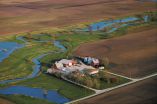(Press-News.org) Roughly 1 in 4 women having breast conserving surgery (BCS) return to the surgical suite for further resection because of cancerous tissue left behind due to unclear margins. Investigators at the Optics in Medicine Lab at Dartmouth's Thayer School of Engineering and Norris Cotton Cancer Center, led by Brian W. Pogue, PhD and Keith Paulsen PhD, with first author and PhD candidate David M. McClatchy III, devised a novel approach to perform near infrared (NIR) optical measurements of resected breast tissue after the margins have had their traditional marking by the surgeon to preserve information about their orientation for potential follow-up surgeries. Their findings are presented in a Letter in the Journal of Biomedical Optics titled, "Molecular dyes used for surgical specimen margin orientation allow for intraoperative optical assessment during breast conserving surgery."
"This work is a significant step towards making NIR optical methods for intraoperative breast tumor margin assessment clinically feasible by not compromising the current surgical practice of inking resected specimens for margin orientation," explained McClatchy.
Breast conserving surgery, where only a small volume of tissue around a breast cancer tumor is surgically removed, is becoming a more common choice for women with localized breast cancer who previously would have selected mastectomy for their surgical therapy. In BCS, it is often difficult for the surgeon to locate and resect the cancerous tissue all around the core of the tumor. This leads to a high frequency of returns to surgery for further resection.
Dartmouth's Optics in Medicine Lab, and the entire biomedical optics community, has focused on developing a system to use intraoperatively to determine whether the margins of resected breast specimens are free of cancer during surgery. The goal of intraoperative imaging is to avoid follow up resections.
This study focused on coming up with a practical solution that both preserves the surgical practice of inking the margins of the tumor, and allows quality imaging post-inking. The group found FD&C food dyes could be substituted for previously used inks that attenuated the NIR signal as to render the images useless. The food dyes do not attenuate the NIR optical signal and allow crisp intraoperative imaging. After imaging, the traditional surgical inks are applied, as they are needed for histopathological processing.
"This is the first breast tumor margin assessment system that is able to interrogate the breast tissue by seeing through dyes or inks used for marking specimen orientation," said McClatchy. "It facilitates a key step toward clinical translation of NIR techniques for breast tumor margin assessment, both here at Dartmouth, and in the biomedical community at large."
Looking forward, the group is co-registering their imaging technique to gross histopathology of freshly excised breast tissue specimens, and creating a database to correlate their imaging technique to breast tissue pathological diagnoses. This will allow the investigators to determine the status of breast tumor margins in real-time during surgical procedures.
INFORMATION:
The Optics in Medicine Lab used Dartmouth's existing technology and surgeries were performed at Dartmouth-Hitchcock Medical Center by Richard J. Barth Jr., MD, who collaborated with Chair of Pathology, Wendy Wells, MD.
Barth and Paulsen are Professors of Engineering at Dartmouth's Thayer School of Engineering. Their work in cancer is facilitated by Dartmouth's Norris Cotton Cancer Center (NCCC) where Paulsen leads the Cancer Imaging and Radiobiology Research Program and Pogue is a member. Barth is Associate Professor of Surgery at Dartmouth's Geisel School of Medicine. He is a member of NCCC's Immunology and Cancer Immunotherapy Research Program. Wells is Professor of Pathology at Geisel and a member of NCCC's Cancer Control Research Program. Other team members include Thayer School of Engineering professors Stephen C. Kanick PhD, Venkataramanan Krishnaswamy, PhD, and Jonathan T. Elliott, PhD.
Support for this research came from the National Cancer Institute and National Institutes of Health RO1 CA192803 as part of an Academic Industry Partnership between Dartmouth and PerkinElmer.
About Norris Cotton Cancer Center at Dartmouth-Hitchcock
Norris Cotton Cancer Center combines advanced cancer research at Dartmouth and the Geisel School of Medicine with patient-centered cancer care provided at Dartmouth-Hitchcock Medical Center in Lebanon, NH, at Dartmouth-Hitchcock regional locations in Manchester, Nashua, and Keene, NH, and St. Johnsbury, VT, and at 12 partner hospitals throughout New Hampshire and Vermont. It is one of 41 centers nationwide to earn the National Cancer Institute's "Comprehensive Cancer Center" designation. Learn more about Norris Cotton Cancer Center research, programs, and clinical trials online at cancer.dartmouth.edu.
For more information contact Kirk Cassels at 603-653-6177.
(Boston)--Repetitive head injuries that occur during contact sports and military service may accelerate the aging process by increasing the build-up of beta-amyloid in the brain, leading to worse disease and an increased likelihood of developing dementia. In particular, boxers fared the worst among athletes and military veterans with a history of head injuries.
These findings, which currently appear online in the journal Acta Neuropathologica, is the first to establish the age-dependent deposition of beta-amyloid in chronic traumatic encephalopathy (CTE), and may lead ...
URBANA, Ill -- Wetlands created 20 years ago between tile-drained agricultural fields and the Embarras River were recently revisited for a new two-year University of Illinois research project. Results show an overall 62 percent nitrate removal rate and little emission of nitrous oxide, a potent greenhouse gas.
"Slowing down the rate of flow of the water by intercepting it in the wetland is what helps to remove the nitrate," says Mark David, a University of Illinois biogeochemist in the College of Agricultural, Consumer and Environmental Sciences. "The vegetation that ...
The act of identifying a perpetrator does not just involve memory and thinking, but also constitutes a moral decision. This is because, by the act of identifying or not identifying someone, the eyewitness runs the risk of either convicting an innocent person or letting a guilty person go free.
In an article published recently in Archives of Scientific Psychology, Spring et al. (2015) discuss two studies in which children and adolescents of different ages watched a film involving a potential wrong-doing: throwing a lit birthday cake into a wastebasket, either with or without ...
A new study published today in the journal Addiction has compiled the best, most up-to-date evidence on addictive disorders globally. It shows that almost 5% of the world's adult population (240 million people) have an alcohol use disorder and more than 20% (1 billion people) smoke tobacco. Getting good data on other drugs such as heroin and cannabis is much more difficult but for comparison the number of people injecting drugs is estimated at around 15 million worldwide.
The "Global Statistics on Addictive Behaviours: 2014 Status Report" goes further in showing that ...
BUFFALO, N.Y. -- Tinnitus is the most common service-related disability for veterans returning from Iraq and Afghanistan. Often described as a ringing in the ears, more than 1.5 million former service members, one out of every two combat veterans, report having this sometimes debilitating condition, resulting in more than $2 billion dollars in annual disability payments by the U.S. Department of Veterans Affairs.
Tinnitus is largely a mystery, a phantom sound heard in the absence of actual sound. Tinnitus patients "hear" ringing, buzzing or hissing in their ears much like ...
Transgenic Huntington's disease monkeys show similarity to humans with Huntington's in their progressive neurodegeneration and decline of motor control, scientists from Yerkes National Primate Research Center, Emory University, report.
These findings are promising for developing a preclinical, large animal model of Huntington's disease for assessing new therapeutics, which could ultimately provide better treatment options, including altering the course of the disease.
In this first multiyear study on a transgenic nonhuman primate model for Huntington's, lead author ...
DURHAM, N.C. -- Lemur girls behave more like the guys, thanks to a little testosterone, according to a new study.
Males rule in most of the animal world. But when it comes to conventional gender roles, lemurs -- distant primate cousins of ours -- buck the trend.
It's not uncommon for lady lemurs to bite their mates, snatch a piece of fruit from their hands, whack them in the head or shove them out of prime sleeping spots. Females mark their territories with distinctive scents just as often as the males do. Males often don't take their share of a meal until the females ...
BROOKLYN, New York -- Researchers have demonstrated a new metal matrix composite that is so light that it can float on water. A boat made of such lightweight composites will not sink despite damage to its structure. The new material also promises to improve automotive fuel economy because it combines light weight with heat resistance.
Although syntactic foams have been around for many years, this is the first development of a lightweight metal matrix syntactic foam. It is the work of a team of researchers from Deep Springs Technology (DST) and the New York University ...
The sun was just beginning to rise as two men headed down to the beach to board a small inflatable boat. Searching for abalone was on their agenda for the day. Their excitement was difficult to contain as they surveyed the coastline looking for sand ridges -- an important clue that abalone may be near. The two men, David Witting and Bill Hagey, share a passion for finding the now rare white abalone and understanding the movement and feeding behaviors of all abalone species.
David Witting, a NOAA Fisheries biologist, has been engaged in efforts to restore abalone populations ...
Many of us are familiar with electrolytic splitting of water from their school days: if you hold two electrodes into an aqueous electrolyte and apply a sufficient voltage, gas bubbles of hydrogen and oxygen are formed. If this voltage is generated by sunlight in a solar cell, then you could store solar energy by generating hydrogen gas.This is because hydrogen is a versatile medium of storing and using "chemical energy". Research teams all over the world are therefore working hard to develop compact, robust, and cost-effective systems that can accomplish this challenge. ...



